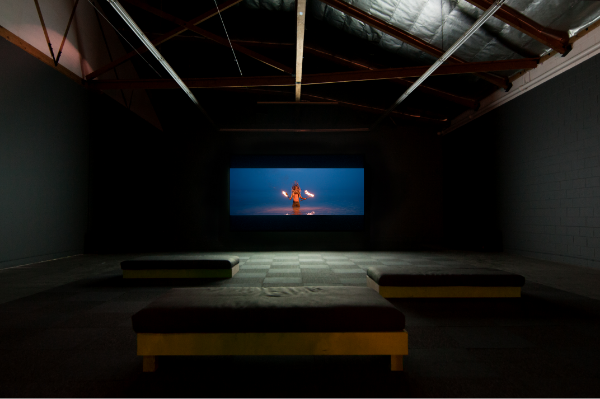Pulau Bidong is a small island near Malaysia that was once a camp for more than 250,000 refugees from the Vietnam War—artist Tuan Andrew Nguyen and his family among them. It has gone feral since being closed in 1991, with dense jungle and crumbling earth overrunning, as Nguyen says, “the relics, the mementos, the mythologies, the mysteries, the memorials, the monuments,” as well as the statuary, shelters, kitchens, and altars erected by its inhabitants, all abandoned. The island is sinking.
In the world of Nguyen’s film, The Island (2017), screening at The Mistake Room, one young man is now the island’s only resident. His days are spent tending to and beating back the vegetation, praying, restoring and maintaining the ruins, and repeating the oral history of his people so that it will not be forgotten—at least for as long as he is alive. The aesthetic quality of his rituals and costumes is inventive and ephemeral, quasi-functional, made of makeshift yet well-chosen materials like wood and stone. It’s a bit like Andy Goldsworthy but much more identity-based. One day a young woman washes ashore from a distant shipwreck. It is revealed that they are the only humans left alive on Earth. An ancient Vietnamese folk story of the enchanted love between a mountain fairy and the Dragon King who rose from the sea is offered as earnest prologue for both the historical and cultural context of this island and its stories.
As much a short feature film—it clocks in at 42 minutes—as a work of video art, the narrative structure of The Island is essentially linear—though it is also circular, fantastical, and at times, journalistic. It was shot on location, and its lush, verdant, oceanic, archeological modern imagery and evocative use of vintage newsreel footage can be appreciated entering the story at any point, though it does have a beginning and end. The man’s monologue becomes dialogue as soon as he pulls the woman from the sea. By the time she arrives, we have been told about and seen footage of and built monuments to families being pulled from the sea in a similar manner. Almost immediately, their conversations turn to the metaphysical search for the meaning of the events that have befallen them, and the question of whether their loyalties are claimed by the past or the future.
Intensely empathetic, the visual experience is as welcoming as the story is unsettling. Multiple languages are spoken, yet the characters have no trouble understanding one another. The storyline is interrupted and peppered with esoteric scenarios and dramatic cinematography. Much is made of the transitory nature of both the island and life itself. In these and other ways, it’s also a film about immigration and identity, place-making, and the shifting meaning of home. One must weigh the value of excavating the past versus inventing the future. Can a person do both? Should they? The film is both educational and enigmatic; one learns facts but can draw no conclusions; one marvels but accepts the fable as truth. Ultimately, each of the two—and of us—chooses a path that represents equally death and life, danger and hope.




















0 Comments